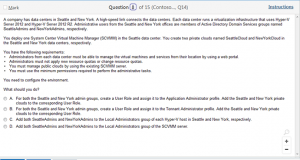QUESTION 1
Your network contains an Active Directory domain named contoso.com. The domain contains a server named Server1. Server1 runs Windows Server 2012 R2 and https://www.leads4pass.com/70-411.html has the Hyper-V server role installed.
On Server1, you create and start a virtual machine named VM1. VM1 is configured as shown in the following table.
You plan to create a checkpoint of VM1.
You need to recommend a solution to minimize the amount of disk space used for the checkpoint of VM1.

What should you do before you create the checkpoint?
A. Decrease the Maximum RAM.
B. Convert Disk1.vhd to a dynamically expanding disk.
C. Run the Stop-VM cmdlet.
D. Run the Resize-VHD cmdlet.
Correct Answer: C Explanation
Explanation/Reference:
Explanation: For checkpoints created when the virtual machine is stopped The checkpoint contains the state of the hard disks only. For checkpoints created when the virtual machine is running 70-414 pdf The checkpoint contains the state of the hard disks and the data in memory. Note: A checkpoint saves the state of each virtual hard disk that is attached to a virtual machine and all of the hard disk’s contents, including application data files. For virtual machines on Hyper-V and VMware ESX 70-414 Server hosts, a checkpoint also saves the hardware configuration information. By creating checkpoints for a virtual machine, you can restore the virtual machine to a previous state.
QUESTION 2
Your network contains a server named Server1 that runs Windows Server 2012. Server1 has the Hyper-V server role installed.
Server1 hosts four virtual machines named VM1, VM2, VM3, and VM4.
Server1 is configured 70-414 dumps as shown in the following table.
You install a network monitoring application on VM2.
You need to ensure that all of the traffic sent to VM3 can be captured on VM2.
What should you configure?
A. NUMA topology
B. Resource control
C. Resource metering
D. Virtual Machine Chimney
E. The VLAN ID
F. Processor Compatibility
G. The startup order
H. Automatic Start Action
I. Integration Services
J. Port mirroring
K. Single-root I/O virtualization
Correct Answer: J Explanation
Explanation/Reference:
Explanation: With Hyper-V Virtual Switch port mirroring, you can select the switch ports that are monitored as well as the switch port that receives copies of all the traffic. And since Port mirroring allows the network traffic of a virtual machine to be monitored by copying the traffic and forwarding it to another virtual machine that is configured for 70-414 exam monitoring, you should configure port mirroring on VM2. References: http://technet.microsoft.com/en-us/library/jj679878.aspx#bkmk_portmirror
QUESTION 3
Your network contains a server named Server1 that runs Windows Server 2012. Server1 has the Hyper-V server role installed.
Server1 hosts four virtual machines named VM1, VM2, VM3, and VM4.
Server1 is configured as 70-414 shown in the following table.
You plan to schedule a complete backup of Server1 by using Windows Server Backup.
You need to ensure that the state of VM1 is saved before the backup starts.
What should you configure?
A. NUMA topology
B. Resource control
C. Resource metering
D. Virtual Machine Chimney
E. The VLAN ID
F. Processor Compatibility
G. The startup order
H. Automatic Start Action
I. Integration Services
J. Port mirroring
K. Single-root I/O virtualization
Correct Answer: I Explanation
Explanation/Reference:
Explanation: The Integration Services settings on virtual 70-414 vce machines include services such as operating system shutdown, time synchronization, data exchange, Heartbeat, and Backup (volume snapshot services). This snapshot will ensure that the state of VM1 is saved prior to backup. References: http://msdn.microsoft.com/en-us/library/dd405549(v=vs.85).aspx Exam Ref 70-410, Installing and Configuring Windows Server 2012, Chapter 3: Configure Hyper-V, Objective 3.1: Create and Configure virtual machine settings, p. 144
Learn more: https://www.examsall.com/microsoft-70-480-exam/
Read more: https://www.microsoft.com/en-us/learning/exam-70-414.aspx